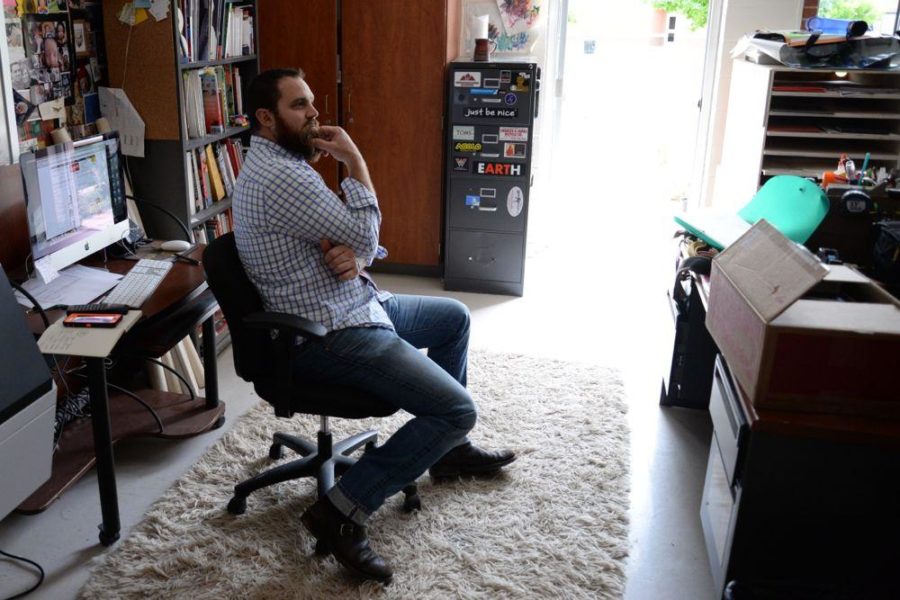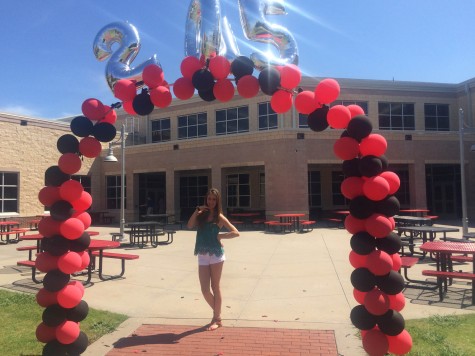McCasland practices what he teaches
Art teacher Brice McCasland works for the school full time, but also paints as a side job.
May 11, 2015
The high school is where he teaches. But it doesn’t define art teacher Brice McCasland as for him there is a world of art festivals and shows beyond the walls of the school.
“When I moved to Texas, and was teaching in Plano, I was painting, and they were horrible,” McCasland said. “Later, I met a contact through the family, and he said “Hey, why don’t you let me see what you’re doing,” and he actually bought a piece. It was the first time that someone bought something because they were drawn to what I was doing, and it opened up a new way of thinking for me.”
From there, McCasland began selling art on an individual basis and travelling for art shows.
“I had a show, and randomly people started contacting me for work, and the workload of what I was doing got so large that I couldn’t keep up and I had to quit teaching,” McCasland said. “So I just painted, and I started doing shows, and when I say shows, I’m talking art festivals, local shows. When I came back here I came back to teaching, I was only doing a few shows, and now I’m doing around 6 a year. Some are in-state, Austin, San Antonio, Houston, and then Chicago, Cherry Creek, and Des Moines. It’s crazy to think that people are interested in what I have to say.”
McCasland has a unique style of art, blending different mediums to create his works.
“I work as a processive collage,” McCasland said. “Staining, acrylic paints, stacking, very physically, almost sculpturally, and then painting on top. It’s really about the positive and negative relationships between the paint, and the paint and the collage, almost serving as a narrative, a base for texture. Collage is meant to narrate what I’m painting on top. You feel like you’re learning things as you go, through the little images that you find, and the paintings themselves.”
Other art teachers at the school support McCasland as both a teacher and a working artist.
“I’ve been to several shows of his,” Art teacher Amanda Beller said. “We actually live fairly close to each other, so I’ve been to his studio, taken my work over, critiqued his work, and it’s really cool because we’re able to give each other feedback.”
His art is inspired by different aspects of his life; much of it is inspired by his son.
“Most of these, a lot of the pieces I do have to do with fatherhood, being a father,” McCasland said. “This is a piece to my son, all the things that I hope he becomes. I think the buffalo is a really good symbol of that because it’s a symbol of what we’ve done wrong. The buffalo is a very sad symbol, but at the same time it’s very stoic and powerful, so this is filled with children’s book pages, single words, and things that I hope he learns and that I teach him as a father. I also do a lot of narrative painting. This one is my son’s stuffed bunny that we lost on the way to an art show in Colorado, but it became this story about all of the things that Old Bunny goes as he travels around with his friends, so that’s the actual old bunny, this is old bunny’s girlfriend. It just helps my son deal with it, to make this adventure.”
He integrates life lessons into his works, philosophies, and stories of his childhood.
“I also do these positive negative animals,” McCasland said. “My mother worked in a playroom in a church, and she did a lot of coloring books, line based drawings that kids would fill in. It was always that there was sense of magic as a kid, that someone gives you something with a line. It’s this famous epic tale or story, and as a kid you take ownership of it, even though you know it’s David and Goliath or something, and you put yourself there as David or Goliath and you color it as a personal experience. That’s what inspired this idea of line drawings, positive and negative relationships.”
These philosophies inspire the way that he teaches as well as his art.
“I think my philosophy teaching is try to be the kind of teacher I would’ve wanted,” McCasland said. “Try to not be a leader of the journey, but a participant in the journey. I have very high standards, I think my kids can tell you that, that’s why a lot of people don’t care for me, because they can’t believe that I would expect them to do something great.”
McCasland’s students mostly appreciate the effort and motivation their teacher invests in them.
“He’s pretty laid back and lets you figure stuff out on your own, but will always help point you in the right direction,” junior Austin Henning said. “I guess he gets you excited about it; he inspires you to work. There’s no rubric or outline, so you just have to motivate yourself and he really helps you with that.”
McCasland strongly believes that hard work and dedication give way to success.
“I think so many people have these awesome opportunities to do something fantastic, and yet we avoid them,” McCasland said. “We want to believe that great things happen with no work, that people get good at things just by showing up and that’s crap. The reason that (these students) are so fantastic is not because of me, it’s because they give a ton of themselves. I think my philosophy is to provide a place and a mindset of commitment, and that through practice, great things happen.”




